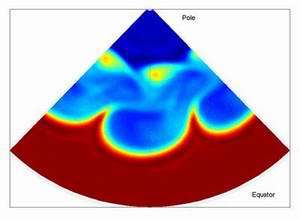Columbia Team Shows How Stratospheric Conditions Affect Weather

Columbia researchers in the Department of Applied Physics and Applied Mathematics in the Fu Foundation School of Engineering and Applied Science (SEAS) are looking toward the upper reaches of the sky to forecast the powerful forces of nature.
The scientists have used a climate model to demonstrate how weather systems and storms may be influenced by disturbances in the stratosphere -- the upper layer of atmosphere 10 to 30 miles above Earth's surface.
Image: This map shows a snapshot of surface temperature in the Northern Hemisphere, with weather systems moving poleward. Columbia researchers have demonstrated that this process is influenced by the presence of a stratospheric jet.
The researchers -- Matthew Wittman, Lorenzo Polvani, Richard Scott and Andrew Charlton -- are part of the Integrative Graduate Education and Research Training (IGERT) joint program in applied mathematics and Earth and environmental sciences, a collaboration of SEAS and the Earth Institute.
Findings from the research were recently published in the American Geophysical Union's journal, Geophysical Research Letters.
"Our research shows that changes to the strength of winds in the stratosphere cause changes to tropospheric weather systems," said lead author Matthew Wittman.
Understanding how the stratosphere affects the troposphere, the lowermost layer of the atmosphere where weather occurs, will help improve seasonal weather forecasts and predictions about the effect of ozone depletion and global warming on our climate. The research is part of the team's ongoing efforts to understand the interaction of the stratosphere and troposphere and improve representation of this interaction in climate models.
"The stratosphere has a longer 'memory' than the troposphere," adds co-author Andrew Charlton. "If you want to make forecasts on a time scale longer than several days, it is useful to understand the mechanisms linking places with longer memories, such as the stratosphere and the oceans to the troposphere."
Each winter, a westerly jet, called the Polar Night Jet, forms in the stratosphere. Winds in this jet circulate around the pole at speeds of up to 100 miles per hour. The strength of the jet changes as part of normal atmospheric variability and possibly also in response to climate change. The authors demonstrate that the presence of stronger westerly jets in the stratosphere causes tropospheric weather systems to track further toward the pole.
Averaging the changes to the paths of weather systems, the team showed, produces a pattern of changes similar in structure to Arctic Oscillation, the dominant pattern of climate variability in the Northern Hemisphere that describes how temperatures across the whole hemisphere vary together.
Source: Columbia University (by Jennifer Freeman)





















